
Open Sundays/Public Holidays 10.00 am to 3.00 pm
Founder Paddy Gleeson:
"King of Clare"

A true specimen of the fine old Irish gentleman was Edward Burton Gleeson, known familiarly as Paddy Gleeson, the King of Clare, who followed pastoral and agricultural pursuits with great perseverance until the time of his death, in 1870.
From: "THE FOUNDER OF CLARE"
"Edward Burton Gleeson was born in County Clare, Ireland in 1803.
-
Gleeson had taken up a British government post in India where he seems to have prospered.
-
In India from at least 1826 with the East India Company, by 1834 Gleeson was “Keeper of the House of Correction” in Calcutta.
-
A widower, he married Harriet Llewellyn Jones in October 1829.
-
Success in the Calcutta Sweepstake apparently facilitated early retirement
With his wife Harriet and family he arrived in South Australia from India in on 27 July 1838 on the "Emerald Isle".
-
By 1840 Gleeson was reported as owning 7,300 sheep, 55 cattle and 24 horses.
-
He initially had land in what is now Beaumont, a suburb of Adelaide, a property he named Gleeville.
-
He reported very favourably on the climate of Adelaide to friends back in India, praising the purity of the air.
-
He was the colony’s largest individual landowner by 1840.
-
The extent of his opulent lifestyle was fully revealed in the insolvency processes which beset him in early 1842.
Arrival in South Australia
At Calcutta on 6th May 1826 Staff Sergeant Edward Burton Gleeson married a Mrs Conway.
-
Her obituary (in Northern Argus of June 19th 1837) referred to her “Welsh extraction,” to the delicacy of the chest [which led to her going] to India with the family of Sir Edward Ryan, where she married the late Mr Gleeson.”
As a widower, he married Harriet Llewellyn Jones in October 1829. At the time of his marriage to Harriet he was Sergeant in the Town Major’s Department.
-
Their third child, Harriet, was born in August 1836 and died in August 1837.
-
Insolvency details revealed he arrived with £4,500 in 1838
- M. Stephanie James
Gleeson had a British government post in India where he seems to have prospered and alongside his East India Company ‘day’ job he also made a tidy sum from investing in local banks.
-
But the tropical climate was having an adverse effect on his brother John’s health, so the Gleesons decided to move to more clement climes in South Australia.
From: Blyth Agriculturist (SA) Wed 4 Jul 1951 Page 4
It is well-known that the Gleeson brothers, their wives and children came to Australia from Madras on the (ship) "Emerald Isle", in July, 1838.
-- Recorded in a short article in the "Southern Australian" Sat. 28th July, 1838;
-- the arrival of the "Emerald Isle" is recorded on Pages 50 and 57 of Opie's Records.
From The Southern Australian, Sat., 28th July, 1838.
The Australian Association of Bengal.

At anchor In Port Adelaide 1839 - five sailing vessels - on the far right: "Emerald Isle"
"On Monday last the "Emerald Isle" a 'fine vessel of 501 tons burden, and drawing 15 1/2 feet: This ship is chartered by the "Australian Association of Bengal" and is the second which that body has despatched from India.
-
She is principally filled with goods (including a packaged timber house) belonging to the passengers on board, who are both numerous and highly respectable."
-
There are some very fine horses, three of which entered Adelaide on Thursday night,
-
One of these is an entire horse of purest Arab blood, and said by the proprietor, Mr. E. B. Gleeson, to be true Nadgad.
-
The passengers per "Emerald Isle" from India, who remain in South Australia:— J. Donithorne, Esq., and servants. E. B. Gleeson, Esq., and Lady, two children and servants. (Paddy's brother) J. H. Gleeson, Esq, and Lady, two children and servants. Dr. Yeatman and Lady, child and servant, Mrs. Balydon



Settled at Gleeville
Edward Burton Gleeson, the founder of the Mid North town of Clare, originally owned a farm within the boundaries of Beaumont in the early 1840s, which he named "Gleeville". The farm included Manning house which was a package house bought over from India with Gleeson.
From: Chronicle (Adelaide, SA) Thu 13 Oct 1932 Page 42 "PADDY" GLEESON: POOH-BAH OF THE LOWER NORTH
"Gleeson arrived in South Australia when it was but nine months old. He came from India, and he brought a batch (24) of Indian servants with him.
-
His first holding was at the foot of the Adelaide hills, the present suburban area known as Beaumont. He called it Gleeville, which name it bore after the property was acquired by Sir Samuel Davenport, and later by the Cleland family.
-
We know that at this time he was one of the wealthiest landholders, for he was the biggest pastoralist in the colony, with the exception, of course, of the South Australian Company.
"It was while he was at Gleeville that one of his servants (when cutting wood in May, 1841) was speared in the neck by a native.
-
In this particular case the Indian was attending to his duties, when a native approached and asked for "baccy."
-
Being told to go about his business, he jabbed his spear into the Indian's neck, the spear coming close to the root of the tongue. The victim managed to crawl to an outhouse, where he was discovered and the alarm given.
-
Dr O'Heay was immediately sent for, and for the timely assistance rendered to him, the man's life was considered out of danger. -- For more stories of these 'Musselmen', ("real paydirt in the dross of historical siftings") consult Jean Schmaal's - The Inchiquin Story (Clare & District National Trust)
"It was also while he was at Gleeville that Gleeson selected the property at Clare.
"If it had not been for his Clare property, Gleeson would have been a broken man during the financial crisis which nearly wrecked the colony on the (1841) dishonoring of Governor Gawler's bills."
"Gleeville," is the site of the first house erected south-east of Adelaide outside the city, the original wooden Manning house, brought from India by E. B. Gleeson.
Left: Manning house at Gleeville, the home of E B Gleeson
-
"Mr Gleeson, a retired Anglo-Indian official, had built a fairly large wooden structure in the neighbourhood.
-
This old house, which was the first dwelling erected on the south eastern side of Adelaide, is still standing on Sir Samuel Davenport's property (1903), and is in a habitable condition, although the timber of which it is composed shews signs of decay." A photograph of the residence built by Mr Gleeson is in the Observer, 7 March 1903, page 23.
"Mr. Gleeson kept a splendid collection of horses in his stables, and entertained lavishly for a few years.
-
A return furnished to Lord John Russell by Governor Grey in May, 1841, mentions that Mr. Gleeson had put down a well 120 ft. deep, with 60 ft of water in it (this well was still present (in 1936), but the water has a high saline content), and
-
that he had erected a substantial dwelling house (mentioned above), outhouses, stables, stockyard, and five cottages for laborers. The land grant of this section 296 is dated March 7,1839.
Gleeson was for some time in partnership with Mr. J. W. Bull, conditioning stock after their long overland journey from NSW, in preparation for sale at the Adelaide market, and was always engaged more or less in agricultural and pastoral pursuits.
-
In 1839 Mr. Gleeson joined John Wrathall Bull in a business to introduce stock from the other colonies. Several herds of cattle passed through their hands with good profit, and a station was formed on Bulls Creek, where overland cattle were fattened and the City of Adelaide supplied with beef and settlers with stock.
-
Several flocks of sheep were also received, chiefly from Tasmania, and were disposed of as stores at the highly satisfactory figure of 38 (shillings) a head.
-
Mr. Gleeson was anxious to begin a breeding sheep station, but on account of the low price ruling for sheep in the older colonies Mr. Bull declined to join him in the venture, and the partnership was ended. - THE FOUNDER OF CLARE
For years he resided at the base of what has ever since borne the name of Gleeson's Hill, near what was for some time the opening of the road to Mount Barker.
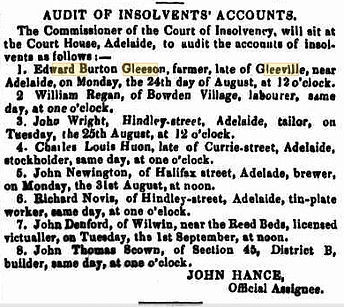

Edward Gleeson was one of those who suffered in the financial crisis of 1842;
-
when everyone who may have held a SA Govt. bill will be called upon to pay its amount as a debtor, and will as a creditor press on his neighbour or the Government, but equally in vain. In such circumstances private credit was at an end
-
and in February of that year two Sheriffs sales were advertised to take place at "Gleeville under the hills."
-
And an Indian bank in which Mr. Gleeson was a large shareholder failed.
His property consisting of 134 acres, afterwards passed into the custody of the bank and was offered for sale."
-
Furniture, books, plate, farming stock, horses, bullocks, agricultural implements, 400 bags of wheat, 350 bags of English barley, 1,500 bags of oats, 50 head of cattle, 1,500 ewes, 1,200 wethers and lambs, and five bales of wool all came under the hammer of the Government Auctioneer, Bentham Neales. The result of the sales was not published in the press, but in his reminiscences Bull says that the sheep realized only 5/ a head.
-
"Gleeson became insolvent, sold the property (via the bank) to Davenport (and) in 1842 moved to his country property "Inchiquin" in the Clare Valley region.
In August, 1846, the property passed into the hands of Sir Samuel Davenport.
(See Audit Notice above)
-
Sir Samuel Davenport had often admired the site as he rode past it on his journey to and from Macclesfield.
-
So Gleeson lost the Burnside property. He was sold up, and the proceeds of the auction were dismally disappointing. But he held onto Clare, and laid out the town.
- THE FOUNDER OF CLARE
Over-spending
Gleeson was adversely affected during the colony's financial crisis in the early 1840s.
-
When Governor Gawler’s overspending became apparent and he was recalled, Gleeson, as a stockholder, attended an 1841 public meeting to clarify the financial position.
-
He was nominated as a member of the ‘Cattle and Horses’ division of the Statistical Society whose role was to present accurate details to the public.
Despite this position, he was among those farewelling the recalled governor in June. 1841
-
In mid-January 1842 the Legislative Council called him as one of ten leading agriculturalists to discuss the state of the Province.
-
He later attended a meeting to consider the “Financial Position of the Province.”
E. B. Gleeson's own account-keeping was about to reveal major discrepancies.
-
His perceived social and cultural capital placed him at the centre of colonial financial consultation,
-
while his own financial position was in complete disarray.
-
Gleeson’s early expenditure pattern matched his high colonial profile.
-
His tailor’s bill increased by 200 per cent between 1839 and 1841, and
-
he spent £2,400 on his household between July 1838 and March 1842,
-
plus £309 on wages for five house servants.
-
Over the same period he outlaid £1,750 on land.
-
-
Gleeville attracted a further £5000 on buildings and improvements;
-
£100 went to the construction of a North Adelaide property in 1841,
-
and over £7,000 on livestock.
-
The Bank of South Australia was owed £3,500.
-
John Morphett and brother held another mortgage of £647. for the Hutt River property.
-
-
March 1842 represented public days of reckoning for Gleeson:
-
his economic tightrope balancing was fully exposed, and
-
his accounting approaches were found wanting.
-
The colony’s financial crisis, in combination with the failure of an Indian bank in which he was a significant shareholder, forced the humiliating public disposal of his assets.
-
Gleeson’s creditors initiated his becoming the colony’s 39th insolvent;
-
his debts totalled £9,986 while credits were £3,078.47
-
A Sherriff’s Sale held on behalf of the Bank of Australasia netted a mere £19.18.5.
-
Insolvency proceedings required individuals to explain the cause of their financial situation.
In addition to buying and improving land and stock, Gleeson attributed his losses to three factors:
-
the sudden depreciation in his fund values,
-
partnership problems associated with John Wrathall Bull,
-
and the shortfall experienced on “Merchandise imported from India.”
Gleeson retreated to his distant Hutt River site, 500 acres from the Special Survey.
-
He possibly received further overseas finance.
-
The previous August, as the colony grappled with sheep scab, Gleeson was shown with a flock of 3,500 in the Wakefield area.
These details are from a thesis BECOMING SOUTH AUSTRALIANS?
THE IMPACT OF THE IRISH ON THE COUNTY OF STANLEY, 1841-1871 By M. Stephanie James
Gleeson was charged by the Insolvency Court in 1845, causing him to be detained until he found bail on April 29 1845. (Ashton's Hotel p. 317)
He withdrew from the Adelaide existence in which he had prospered and headed north to the Hutt River land he had selected following the Special Survey of 1841.
-
Gleeson prospered in the mid-north, where he established his property Inchiquin and laid out the town of Clare in 1841, named after his birthplace.
-
He also held land leases around Condowie, at Black Point, east of CLare (see map at left), and in the far north, west of Mount Eyre
-
but concentrated upon his property at Clare.
Read More about Gleeson's Black Point leases (now Snowtown) -
He became the first mayor of Clare when it was proclaimed a corporation in 1868.
While the decision to exit from Adelaide was precipitated by insolvency, Gleeson’s actions in Stanley demonstrated great commitment to that region.
"His successes could have facilitated a full return to Adelaide society;
however, Gleeson chose to reside in Clare and to devote his energies to that region.
Departing from the colony seems never to have been considered, thus Gleeson was registering allegiance to his chosen home."
- M. Stephanie James
Inchiquin Homestead
Gleeson’s homestead, Inchiquin, was probably built in about 1845.
The nature of his establishment was consistent with ... “the best aspects” of the Irish ascendancy:
establishing a landed colonial gentry which would be paternalistic, responsible, cultivated and civilised,
attracting, and on good terms with, its Irish Catholic employees:
it was to be the Anglo-Irish dream, pure and realised.
Such approaches when applied to Gleeson’s behaviour underlined his self-appointed status of “Squire” with the imposing house set amidst garden and orchard.
The stone was local, and Mintaro slate was incorporated.
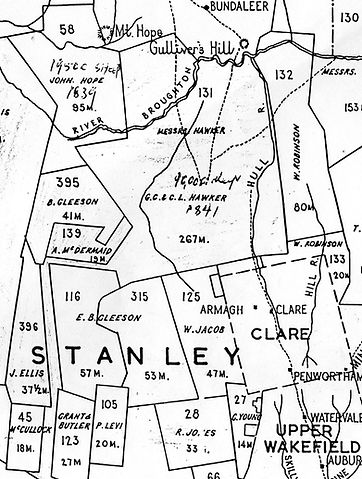

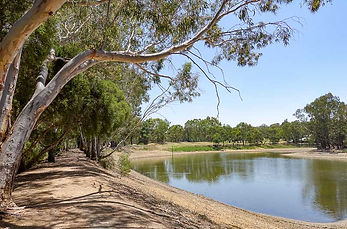
Life at Clare
Sources differ in their accounts of Gleeson’s initial journey to ‘Clare’
– it might have been in 1840 or 1841 that he travelled for seven to eight days accompanied by blacksmith John Maynard in a bullock wagon, and camped under the huge gum tree.
Gleeson left flocks, Indian labourers and John Maynard, plus an overseer, and returned to Adelaide.
-
But in 1842, after the January public meeting and the signing of insolvency papers on March 26th, he was not in Adelaide.
Despite the embarrassment associated with insolvency, the attendant publicity and inevitable social isolation,
-
Gleeson’s Hutt River property,
-
plus personal resilience,
-
enabled him to overcome some loss of social and cultural capital,
-
negotiate the difficult times,
-
and emerge ready for renewed efforts.
"Gleeson was a fine character. He was an Irishman, and he scattered little bits of the Emerald Isle all about him.
He called the site of the town Clare after his native country.
Left: Inchiquin Homestead, Main North Road, Clare SA
When Edward Burton Gleeson divided his land into blocks in 1838, he called his homestead "Inchiquin," after Lord Inchiquin, head of the historic house of O'Brien, of Clare, set on a modest 500 acres, and
-
Two adjacent villages, were given the names of Armagh and Donny-brook.
Inchiquin is the earliest of Clare's larger houses and properties to have survived. The homestead is closely associated with Edward Burton Gleeson the founder of Clare.
-
It is one of the finest pastoral homesteads in the Lower North.
-
At Inchiquin, the first HARVEST HOME Festival (and Agricultural Show) was held on 14th December, 1840.
-
Old Inchiquin was a plain, white washed building with a thatched roof, and was built by Edward Burton Gleeson on the site of the present tennis court. There was a stone structure at the back where the residence now stands.
-
Our last Mayor of Clare, Allan Aughey and wife Lyn now live in Inchiquin House.
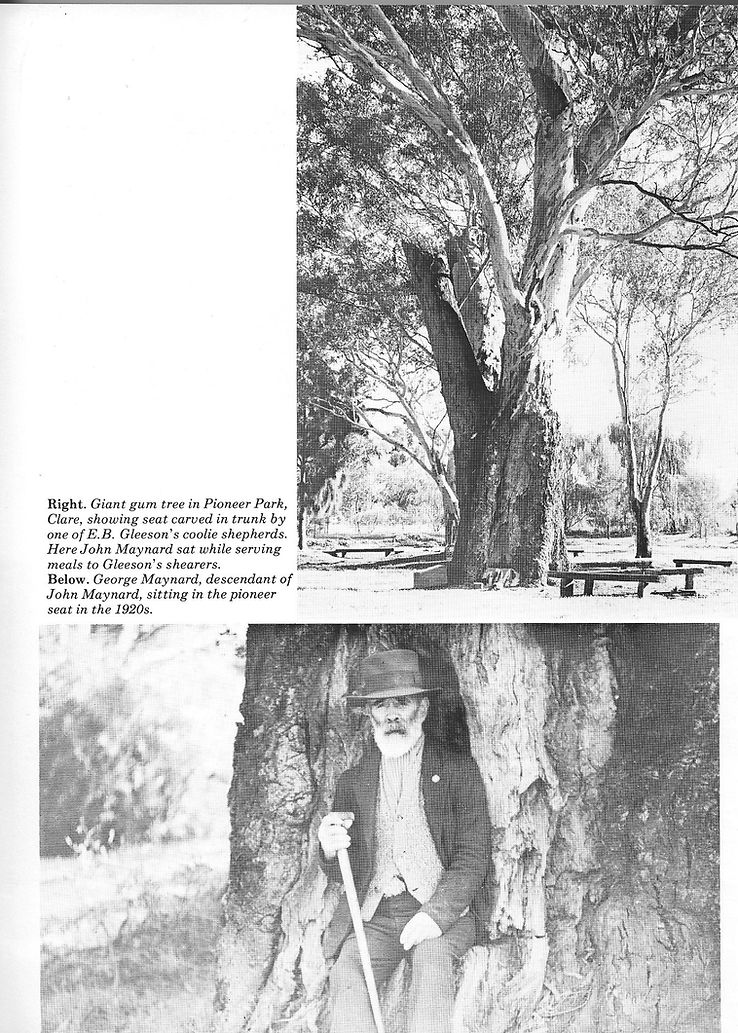
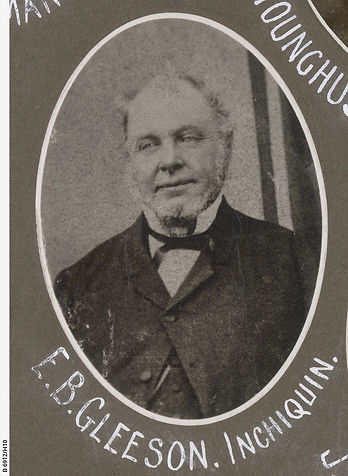
Above: The old gum tree in Pioneer Park, with a carved seat for Mayor Paddy Gleeson, from Bob Noye's "Clare"
Clare, like Adelaide, was born under a gum tree. That tree, like the old veteran at Glenelg, still stands.
-
It was under its shelter in 1838, when the colony was in its swaddling clothes, that E. B. (Paddy) Gleeson, looking for a site for a station, pitched his tent with an air of "Here I am, and here I stay."
-
And he did stay.
In the photograph of the old tree on this page, you will see the seat, that one of the Indian servants, a clever axe-man named Gongo, carved for his master.
Mayor Paddy Gleeson will be sorely missed in Clare;
-
for his peculiar knack of peacemaking;
-
his presence at public meetings for the promotion of religion, science, or charity,
-
his worth as a Special Magistrate dispensing evenhanded justice,
-
and his readiness to attend to duty, and by his friends (whom he) met daily.
The official return of the pastoral leases taken out between 1851 and 1864 shows that Gleeson held:
-
41square miles of country east of the Hummocks,
-
and 117 square miles west of Mount Eyre,
from the summit of which the explorer Eyre got the first view of Lake Torrens. -
By the 1850s he had acquired leaseholds on a massive 150,000 acres and turned his family into something approaching local aristocracy.
From: Blyth Agriculturist (SA) Fri 21 Nov 1941 Page 2
"I do not know why they made Clare a corporate town in '68. It was very small potatoes in those days, though I suppose that, as a matter of relativity—with apologies to Professor Einstein— it was an important place.
-
The photograph on this page will show you it was far from being the picturesque ville we know today.
-
If Clare was founded by one Irishman, its first buildings were erected on the section of another. It belonged to Dr. Murphy, first Archbishop of Adelaide. He owned section 39.
-
This property his Grace subdivided and sold by public auction, and on it were erected the few scattered humpies which formed the nucleus of the town.
-
The first buildings in Clare itself were erected on the section owned by Bishop Murphy, and the first hut within the town boundary was built by John Maynard.
Clare was proclaimed a district council in 1852. The first chairman was Gleeson. He was a sort of Pooh-Bah of the Lower North. Gleeson ran everything.
-
He was president or chairman of almost every activity for miles around. They called him the "King of Clare."
In 1868 Clare was made a corporation. Of course his majesty of "Inchiquin" was the first mayor. But he seems to have ruled his 800 subjects with a light sceptre, for there is no gainsaying the fact that he was extremely popular.
-
The old photograph reproduced here shows Clare in 1870. It depicts Main street looking south.
"Some of my informants remembered "Paddy" Gleeson, very short and stout, and riding an old grey cob, using the mounting stone which used to be in front of Ford's Hotel. This stone has disappeared, and no one seems to know what has become of it. But you may still see the leadlights intact in what used to be Ford's bar."
-Clare: Garden Of The State
When he died two years later the shops and hotels on the main street closed in his honour.
-
He was a friend of John Horrocks, a fellow pastoralist in the Clare region and an explorer.
-
Known as Paddy Gleeson, he was the unofficial 'King of Clare' and a popular identity.
-
He was also a stipendiary magistrate and a keen sportsman, interested in horse racing." - SA Memory
The Corporation of Clare was proclaimed in September, 1868.
"Paddy Gleeson, King of Clare." as he was nicknamed, (being very short and stout), became first Mayor.
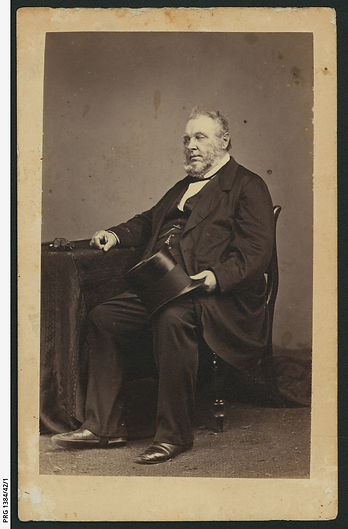
Mayor Gleeson
-
Was at one stage the postmaster of Clare
-
was present at the first Race Meeting held in SA, his mare "Kitty" winning a purse of 20 guineas - Jean Schmaal
-
claimed to be (one of) the first to reap a crop of grain in SA - Jean Schmaal
-
often acted as Foreman of the Grand Jury before that institution was abolished,
-
was Returning Officer for his electoral district, and
-
has been often solicited to enter Parliament as the representative of the part of the country with which he was so intimately connected;
-
but his many avocations, public and private, at home, always prevented his acceding to the reiterated request.
Mayor Gleeson was connected with many leading events in Clare and its neighborhood.
-
For some years he discharged the duties of Stipendiary Magistrate there, and was in every local movement that was worthwhile.
-
In 1846 he shot the camel (belonging to Horrocks's expedition) that was the indirect cause of the explorer's death. He did this by the dying man's orders. He was much affected by his friend's tragic ending, his hand was unsteady, and he missed his aim.
-
In 1850 Mr. E. B. Gleeson laid the first stone of St. Barnabas' Church.
-
During the Irish Famine he encouraged Irish people to emigrate to the Clare valley and when, in the early 1850s, the St Patrick’s Society brought out 5,000 Irish girls to work in South Australia as servants, Clare was one of the handling stations for the operation.
-
‘Paddy’ seems to have been a pretty canny farmer; by the 1850s he had acquired leaseholds on a massive 150,000 acres and turned his family into something approaching local aristocracy.
-
In 1860 six of John McDouall Stuart's party were entertained at Inchiquin.
The late E. B. Gleeson Inchiquin Clare
-
In 1862 Mr. Gleeson headed a party who rode out on the Bungaree road to meet the remains of Burke. These bones were carried on the smallest of eight camels, and were covered with the Union Jack. Howitt was the leader of the expedition, which, being short of provisions, had killed and eaten 30 of their horses, which they declared to be excellent eating, and as nutritious as beef and mutton. The handful of bones, all they could discover of Burke and Wills, were buried in Melbourne. Burke's orders in this respect were disregarded, as he wished for no burial, but to be laid on the ground with his revolver in his hand, and his feet towards Melbourne.
-
In 1863 Julia Hill opened the Inchiquin Bridge, on the North road from Clare.
-
Mr. Jonathan Filgate, who married Miss Fanny Gleeson, entertained the contractor and laborers at the Thistle and Shamrock.
-
In 1867 the first Clare Show was held. Mr. Gleeson, S.M., presided over the dinner.
In 1870 Mr. Gleeson died. His remains were carried from Inchiquin to St. Barnabas' churchyard, attended by Freemasons. Oddfellows, and Foresters. 100 strong, 80 vehicles and 100 horsemen followed. "The King of Clare" was placed in his grave by (his) old servants.
After his death Inchiquin passed to his only surviving son. Mr. J. W. Gleeson, an auctioneer and commission agent, of Clare, who was born in India and came to the colony in the Emerald Isle in 1838. His brother Edward Burton Gleeson, had died after a horse accident.
-
The Inchiquin garden was something more than the gardens of early days, and William Smoker, the gardener, grew splendid pineapples. There was also a fine orangery.
-
The Gleesons were there from 1838 to 1884, when the Hills acquired the property. Eventually the property passed into other hands.
-
Betty Westwood, (1917-2004) of Dollar Cottage (Strathalbyn, S.A.) left her family records to the State Library, explaining the family history connection and relationship to the old (Gleeson) Pioneer's house in Clare called 'Inchiquin'. Betty gave the tapestry stool now in our Clare Museum.
-
Mrs. E. B. Gleeson survived her husband many years, and died at a great age.
-
Gleeson, Burton, and Fanny streets in Clare, all remind us of Clare's founder.
The Gleeson Family
From: The Mail (Adelaide, SA) Sat 13 Mar 1937 Page 23
-- Inchiquin Romantic House of 100 Years
Edward Burton Gleeson brought Harriet, his wife, and two eldest children with him when he came from India in the "Emerald Isle" in 1838, and later took up land near Clare.
Paddy's children were:
-
John William, who succeeded his father at Inchiquin, and
-
Edward Burton, who was thrown from his horse and killed in 1853 while after cattle.
The daughters were -
Annie, Sarah Ann Circa 1841 - 1928
Sarah married George Henry Hamilton Ayliffe, born on May 25 1840, of Adelaide, South Australia.
-- Sarah was the youngest Gleeson daughter and, waiting until she was 21, she eloped with young George and lived happily ever after. -- Trooper George Ayliffe had been involved in the Rainbird Murders while stationed at Kapunda police station, but was then posted to Clare. -- They had 8 children:
Beatrice Kathleen Windebank (born Ayliffe), Claude Hamilton Ayliffe and 6 other children.
-- Sarah passed away in 1928, at age 87 -
and Fanny, who married Jonathan Filgate, a brewer, of Clare. When he died, she took over and ran the brewery herself. (No mean feat.)
Harriet (after whom Harriet Street, Clare was named) was old Mrs. Gleeson, who laid the first stone of St Barnabas' Church, Clare, in 1850.
-
On the death of her husband (1870) she left Inchiquin and lived with her daughter, Mrs. Filgate, at Burton Cottage.
-
She died at a good old age, though no one exactly knew how old she was, as she was reserved on the subject.
The surviving son John W. Gleeson married Miss Alston.
Their children were
-
Edward Burton, otherwise Bertie, a young man of great promise, and
-
Mary (Mrs. Laurie Taylor, of Strathalbyn).
Bertie was engaged to the sister of Mr. Justice Buchanan. She was called Penang, the shortened form of her name, Penelope Ann.
-
Bertie's untimely death from pneumonia (1883) crushed his parents' hopes, and ultimately led to the sale of Inchiquin (1884).
-
The Gleesons remained in Clare till Mr. John Gleeson's death, when his widow went to live with her daughter, where she died.
-
The Gleesons are buried in the family vault in St. Barnabas' Churchyard (now closed).
Mr Hampton Gleeson born in Calcutta on the 14 Sep 1829, was the eldest son of John Hampton Gleeson (Paddy Gleeson's brother) and so was Paddy's nephew, who with (Paddy) Edward Burton Gleeson and their families emigrated to South Australia from Calcutta on the Emerald Isle, arriving in July 1838.
-
Besides the two Gleeson families and a few other settlers (notably Judge James Donnithorne) and their servants,
-
the ship carried a number of Indian coolies, a large quantity of Indian merchandise and horses, including "Abdallah", an Arab stallion brought out by E. B. Gleeson for breeding purposes.[2]
-
There were (unspecified) problems with the Emerald Isle and her master.[3]
-
Hampton's father, John Hampton Gleeson died in 1840, when his son was barely six years old.
-
Hampton was the God-Child of Pioneer John Hope
-
Somehow Paddy's nephew Hampton received on excellent education and developed a keen business sense, perhaps at his uncle's property "Inchiquin" near Clare. -- Read More at Wikipedia.
Read More:
-
Snowtown Pastoral Pioneer: Paddy Gleeson of Clare
-
Arminta Wallace, Paddy Gleeson and the Clare Valley Sat, May 13, 2017, tintean.org.au
-
FIRST HOUSE SOUTH-EAST OF ADELAIDE - Letter to the Editor from J. B. CLELAND, Beaumont. The Advertiser (Adelaide, SA) Sat 8 Feb 1936 Page 22
-
Inchiquin Romantic House of 100 Years - The Mail (Adelaide, SA : 1912 - 1954) Sat 13 Mar 1937 Page 23
-
Jean Schmaal, The Inchiquin Story, Clare & District National Trust, c.1980
-
LINKS WITH THE PAST - "PADDY GLEESON, KING OF CLARE" AND FUNERAL CORTEGE OF BURKE AND WILLS AT CLARE IN 1862, INCHIQUIN BRIDGE OPENED 1863 Blyth Agriculturist (SA : 1908 - 1954) Fri 21 Nov 1941 Page 2
-
Obituary - E.B. Gleeson, Clare South Australian Register (Adelaide, SA) Tue 1 Mar 1870 Page 8
-
"PADDY" GLEESON: POOH-BAH OF THE LOWER NORTH - Chronicle (Adelaide, SA) Thu 13 Oct 1932 Page 42 - TOWNS, PEOPLE, AND THINGS WE OUGHT TO KNOW
-
Robert J Noye "Clare. a District History" District Council of Clare and Gilbert Valleys and Clare Regional History Group, 1997
-
SA Memory - S.A. Northern Pioneers: E.B. Gleeson
-
THE FOUNDER OF CLARE, Northern Argus (Clare, SA)Fri 6 Jun 1924 Page 8



